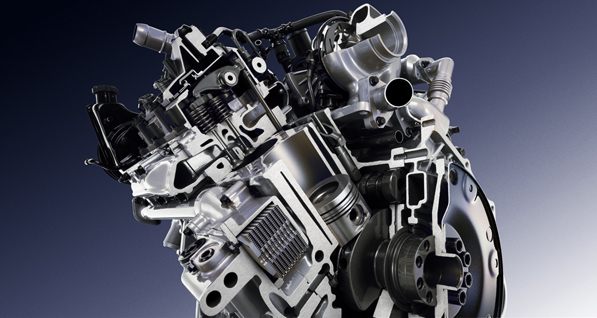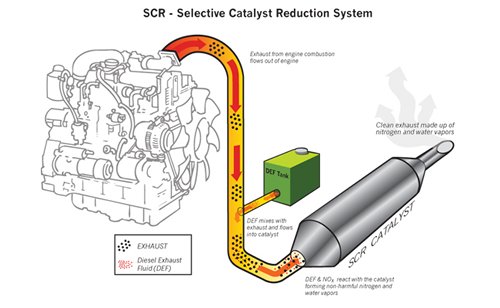It’s kind of funny because 20 years ago, no one wanted a clacking bucket of bolts, let alone have to work on one of these diesel engines. That was simply how the diesel engine was viewed. Now, mid-size trucks offer reliable power, awesome torque, quiet engines and decent fuel economy from a vehicle that can be quite heavy.
In the process of making more reliable power and efficiency, the manufacturers also had to tighten down the emissions from diesel engines. The result has been, in many cases, less than impressive.
If you remember the gasoline era from the ’70s, pollution-controlled vehicles were terrible. In the ’60s it seemed as though we were making power whenever we wanted – and then it came to a halt with smog control.
Take a look at the situation with gasoline engines today. The manufacturers found technology to work in keeping greenhouse gases down and engine performance up. It has all been an intensive learning curve for engine builders.
With diesel engines, that learning curve continues. Power is not the problem – the emissions are. In 1994 the federal government began the first level of emissions reduction for diesel engines. That was the year, incidentally, that the 7.3L Power Stroke engine came to the market and was compliant with Tier 1 regulations. The only pollution control device the engine had was a catalytic converter, simply a diesel oxidation catalyst. The catalyst used oxygen in the exhaust stream to convert carbon monoxide (CO) and hydrocarbons (HC) to H2O and carbon dioxide (CO2 ). These catalytic converters can operate at up to 90 percent efficiency, which helps reduce diesel odor and soot.
For years, diesel engines had what is referred to as a “smoke tube.” This “smoke tube” was close to the ground and allowed crankcase vapors to escape, much like gasoline engines before the use of PCV. The crankcase vapors of today’s engines are ingested back into the engine through the air intake tube. So the 7.3L Power Stroke engine vented no external crankcase vapors into the atmosphere and used just a catalytic converter.
As the years passed, the government would soon clamp down even harder on diesel emissions and raise exhaust regulations of diesel engines to Tier 2. In order to meet the demands of tighter emissions, Navistar introduced the 6.0L DIT engine in 2003. The government then demanded that manufacturers reduce the amount of Nitrogen Oxide (NOx) gas in diesel engines. This is a chemical composition of exhaust in a compression ignition engine that is harmful to the environment. The 6.0L DIT engine incorporated what is commonly known as an EGR valve.
Several things come into play when using an EGR valve on a diesel engine. First of all, the manufacturers have to produce a very efficient engine. People often ask why Navistar took the 7.3L DIT out of production. Simply put, when you ingest exhaust back into the engine the NOx level may be reduced but the level of particulate matter (soot) is greater.
This happens because when you inject exhaust gas into the engine, you dilute the intake charge. When you dilute the intake charge you have cooler combustion temperatures. Cooler combustion temperatures are not as effective in making power and the soot level increases. In order for the engine to make power, manufacturers altered injection timing to compensate for the exhaust gas recirculation. The 7.3L DIT engine was a great power producer, but not as efficient as the 6.0L “emissionsized” engine.
The increased use of EGR valves has led to a bigger problem with soot. So, in order to trap the soot, the government has demanded that all trucks built after January 1, 2007 have a Diesel Particulate Filter (DPF) and a catalytic converter.
In simple terms, the DPF is a huge screen that traps the soot coming from the engine. This filter looks like a rocket shell underneath newer trucks. The DPF has temperature sensors and pressure tubes used by the PCM to help in determining when the DPF screen is full. When the DPF needs cleaning it undergoes what is called “regeneration.”
Regeneration is done differently by the different manufacturers. The most common way is to inject diesel fuel into the exhaust stream in order to raise the temperature. When a certain temperature is reached, the soot will begin to burn out of the DPF that cleans the “screen.” Some manufacturers inject diesel into the exhaust through a separate nozzle in the exhaust pipe before the DPF. Others will pulse the injectors on the exhaust stroke, which will put diesel fuel into the exhaust system. The biggest drawback to this stage of the process is poor fuel economy. The fuel mileage can drop as much as 3 to 4 miles per gallon during regeneration.
Through the smog reduction learning curve of diesel engines, manufacturers have introduced other solutions into production. Selective Catalyst Red-uction (SCR) is something new and has just been released for the 2011 Ford trucks, which uses “Urea” as the catalyst.
To explain in simple terms, urea is an odorless, colorless, non-toxic substance found in urine of mammals. Urea is often used in agriculture in a granular form as a fertilizer because it is rich in nitrogen. But the urea used in diesel exhaust systems is in liquid form. This liquid can now be purchased at most local parts stores under the name Diesel Exhaust Fluid (DEF). This is made from a concentration of liquid urea with a percentage of deionized water. The truck has two tanks inside the fuel filler door; one is for the urea solution (DEF) and the other is for diesel fuel (The fuel tank has a green lid and the DEF has a blue lid).
If you’re thinking, “who cares” or “what is the point?” Well, let’s look a little deeper. When using urea, there is no need to use an EGR valve, which means that the engine will make more power without the diluted intake charge and cooled combustion temperatures. In return there will be less particulate matter from the engine, so there is no need for a DPF.
However, the drawback now is that the engine makes NOx. So in order to combat the problem, urea is injected through a nozzle downstream in the exhaust system somewhere shortly after it exits the turbo. Remember from biology classes that this is a catalyst, so the process will separtate the molecules. The urea has a reaction with the NOx gas. This reaction turns the NOx into ammonia. The ammonia enters the catalytic converter where it is separated into nitrogen and water.
If you think about it, SCR is the best choice for reducing emissions in diesel engines. Yes, there’s the added expense of the DEF, but in return you make more power and obtain better fuel economy. Manufacturers can now vary the engine’s injection timing to produce more power. With that, the engine will be less likely to produce soot, reducing the chances of having to replace the DPF (at a cost of around $2,000) if it becomes clogged and won’t regenerate.
Robert McDonald is owner of New South Diesel in Newton, NC, and specializes in high performance diesel and gasoline engines and cylinder heads for street, marine, dirt and drag racing. You can reach Bob at [email protected]. 














